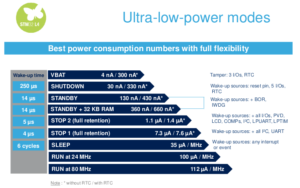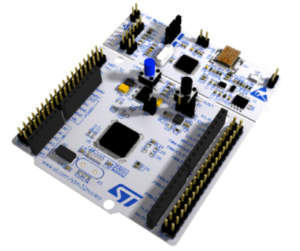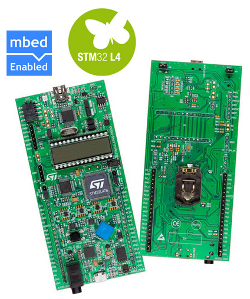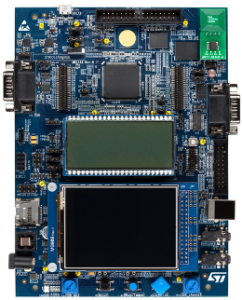
Introduction
STM32L4 series of ultra-low-power has built a new architecture to reach best-in-class ultra-low-power figures thanks to its high flexibility.
STM32L4 MCUs have scored 177 in the standardized EEMBC™ ULPBench® tests that compare the efficiency of ultra-low-power microcontrollers.
Moreover, the STM32L4 series shatters performance limits in the ultra-low-power world. It delivers 100 DMIPS based on its ARM® Cortex®-M4 core with FPU and ST ART Accelerator™ at 80 MHz.

STM32L4 microcontrollers offer dynamic voltage scaling to balance power consumption with processing demand, low-power peripherals (LP UART, LP timers) available in Stop mode, safety and security features, smart and numerous peripherals, advanced and low-power analog peripherals such as op amps, comparators, LCD, 12-bit DACs and 16-bit ADCs (hardware oversampling).
The series are available in different lines:
- STM32L4x1 (Access line)
- STM32L4x2 (USB Device)
- STM32L4x3 (USB Device, LCD)
- STM32L4x5 (USB OTG) and STM32L4x6 (USB OTG, LCD).
To simplify migration and give you all the flexibility you need, the STM32L4 is pin-to-pin compatible with the different STM32 series and opens the door to the full STM32 ecosystem.
- Ultra-low-power mode: 8 nA with backup registers without real-time clock (5 wakeup pins)
- Ultra-low-power mode + RTC: 200 nA with backup registers (5 wakeup pins)
- Ultra-low-power mode + 16 Kbytes of RAM: 170 nA
- Ultra-low-power mode + 16 Kbytes of RAM + RTC: 450 nA
- Dynamic run mode: down to 84 μA/MHz
- Wake-up time: 5 μs


Go on TOP
–
Evaluation Board
NUCLEO-L476RG
STM32 Nucleo-64 development board with STM32L476RGT6 MCU, supports Arduino and ST morpho connectivity.
The STM32 Nucleo board provides an affordable and flexible way for users to try out new ideas and build prototypes with any STM32 microcontroller line, choosing from the various combinations of performance, power consumption and features.
The Arduino™ connectivity support and ST Morpho headers make it easy to expand the functionality of the STM32 Nucleo open development platform with a wide choice of specialized shields.
An ST-LINK/V2-1 is integrated on the board, as embedded in-circuit debugger and programmer for the STM32 MCU and USB Virtual Com Port bridge.
The STM32 Nucleo board comes with the STM32 comprehensive software HAL library together with various packaged software examples, as well as direct access to mbed online resources.

….
STM32L4-Discovery – with STM32L476VG MCU
The 32L476GDISCOVERY helps users to develop and share applications with the STM32L4 ultra-low-power microcontrollers.
The Discovery kit combines STM32L476 features with LCD, LEDs, audio DAC, sensors (microphone, 3 axis gyroscope, 6 axis compass), joystick, USB OTG, Quad-SPI Flash memory, expansion and probing connectivity.
It includes an embedded Ammeter which measures the MCU consumption in low power modes.
An ST-LINK/V2-1 is integrated on the board, as embedded in-circuit debugger and programmer for the STM32 MCU and USB Virtual Com Port bridge.
An external board can be connected thanks to extension and probing connectors.
VIDEO – Getting Started with STM32L476 Discovery

…
STM32L476G-EVAL
STM32L476G-EVAL, Evaluation board with STM32L476ZG MCU
The STM32L476G-EVAL evaluation board has been designed as a complete demonstration and development platform for STMicroelectronics ARM® Cortex®-M4 core-based STM32L476ZGT6 microcontroller with three I2C, three SPI, six USART, CAN, SWPMI, two SAI, 12bit ADC, 12bit DAC, LCD driver, internal 128 Kbyte SRAM and 1 Mbyte Flash memory, Quad SPI, Touch sensing, USB OTG FS, LCD controller, FMC, JTAG debugging support.
The full range of hardware features on the board can be used to evaluate all peripherals (USB OTG FS, USART, digital microphones, 12bits ADC and DAC, dot-matrix TFT LCD, LCD glass, IrDA, LDR, SRAM, Nor Flash, Quad SPI memory, MicroSD card, Sigma-delta modulators, Smartcard with SWP, CAN, I2C EEPROM, RF-EEPROM) and develop user’s applications.
Extension headers make it possible to easily connect a daughterboard or wrapping board for a specific application.
An ST-LINK/V2-1 is integrated on the board, as embedded in-circuit debugger and programmer for the STM32 MCU and USB Virtual Com Port bridge.

A complete list of the evaboards is here.
Go on TOP
TUTORIAL
- Become an STM32L4 expert with STM online training
- VIDEO – Getting Started with STM32L476 Discovery
- For latest news concerning the “Introduction to STM32L4” see here.
- Introduction to STM32L4 GPIO – (see for video here)
- Introduction to STM32L4 Timers, see also this Application Note:
- Introduction to STM32L4 IRTIM (Infrared Timer) – (see for video here)
- Introduction to STM32L4 LPTIM (Low-power timer) – (see for video here)
- Introduction to STM32L4 RTC – (see for video here)
- Introduction to STM32L4 SYSCFG – (see for video here)
- Introduction to STM32L4 RCC (Reset and Clock controller) – (see for video here)
- Introduction to STM32L4 SPI – (see for video here)
- Introduction to STM32L4 I2C – (see for video here)
- Introduction to STM32L4 USART – (see for video here)
- Introduction to STM32L4 LPUART – (see for video here)
- Introduction to STM32L4 ADC – (see for video here)
- Introduction to STM32L4 DAC – (see for video here)
- Introduction to STM32L4 VREFBUF (Voltage Reference Buffer) – (see for video here)
- Introduction to STM32L4 OPAMP (Operational Amplifier) – (see for video here)
- Introduction to STM32L4 COMP (Comparators) – (see for video here)
- Introduction to STM32L4 SWPMI (Single wire protocol master interface) – (see for video here)
- Introduction to STM32L4 USB – OTG_FS (Universal serial bus on-the-go full-speed) – (see for video here)
- Introduction to STM32L4 CAN – (see for video here)
- Introduction to STM32L4 CRC – (see for video here)
- Introduction to STM32L4 NVIC (nested vectored interrupt controller) – (see for video here)
- Introduction to STM32L4 DFSDM (Digital filter for Sigma-Delta Modulators) – (see for video here)
- Introduction to STM32L4 SDMMC (Secure Digital I/O and MultiMedia Cards) – (see for video here)
- Introduction to STM32L4 SAI (Serial audio interfaces) – (see for video here)
- Introduction to STM32L4 LCD (Liquid crystal display controller) – (see for video here)
- Introduction to STM32L4 TSC (Touch sensing controller) – (see for video here)
- Introduction to STM32L4 PWR (power management functions) – (see for video here)
- Introduction to STM32L4 DMA – (see for video here)
- Introduction to STM32L4 EXTI (extended interrupts and events controller) – (see for video here)
- Introduction to STM32L4 IWDG (Independent watchdog) – (see for video here)
- Introduction to STM32L4 WWDG (System window watchdog) – (see for video here)
- Introduction to STM32L4 Device Electronic Signature – (see for video here)
- Introduction to STM32L4 DEBUG – (see for video here)
- Introduction to STM32L4 Embedded Flash Memory – (see for video here)
- Introduction to STM32L4 Quad SPI memory interface (QUADSPI) – (see for video here)
- Introduction to STM32L4 Flexible Static Memory Controller (FSMC) – (see for video here)
- Introduction to STM32L4 CRC (Cyclic Redundancy Check) – (see for video here)
- Introduction to STM32L4 FIREWALL – (see for video here)
- Introduction to STM32L4 RNG (Random Number Generator) – (see for video here)
- Introduction to STM32L4 AES (Advanced Encryption Standard HW Accelerator) – (see for video here)
- Introduction to STM32L4 Safety Support – (see for video here)
- Introduction to STM32L4 Memory Protection – (see for video here)
- Minimization of power consumption using LPUART in microcontrollers of the STM32L0 and STM32L4 series (AN4635)
- Using the hardware real-time clock (RTC) in low-power modes with STM32 microcontrollers (AN4759)
- STM32L0/L4 FIREWALL overview (AN4729)
- Getting started with STM32L4 series hardware development (AN4555)
- Oscillator design guide for STM8S, STM8A and STM32 microcontrollers (AN2867)
- STM32 Cube firmware examples for STM32L4 series (AN4726)
- Migrating from STM32L1 series to STM32L4 series microcontrollers is here
- STM32-Discovery example, topics: CUBE, RTC, Blue Button and LEDs
- STM32L4 trainingPrague3d (Jan.2016 STM Prague)
IMPORTANT NOTE
At the moment, the STM32L4_trainingPrague3d shall be issued only to SILICA customers.
If you are SILICA customer send me an email and ask me:
STM32L4_trainingPrague3d
please specify also your City, Country and your contact in SILICA.
If you are STM customer please contact directly your local office of STM. - STM32L4 Tips and Tricks
IMPORTANT NOTE
At the moment, the STM32L4 Tips and Tricks shall be issued only to SILICA customers.
If you are SILICA customer send me an email and ask me:
STM32L4 Tips and Tricks
please specify also your City, Country and your contact in SILICA.
If you are STM customer please contact directly your local office of STM. - STM32L4 trainingPargue1d (Dic.2015 STM Prague 1d – 384Mbyte)
IMPORTANT NOTE
At the moment, the STM32L4_trainingPrague1d shall be issued only to SILICA customers.
If you are SILICA customer send me an email and ask me:
STM32L4_trainingPrague1d
please specify also your City, Country and your contact in SILICA.
If you are STM customer please contact directly your local office of STM. - STM32L4_training (Nov.2015 STM Italy – 487Mbyte)
IMPORTANT NOTE
At the moment, the STM32L4_training shall be issued only to SILICA customers.
If you are SILICA customer send me an email and ask me:
STM32L4_training
please specify also your City, Country and your contact in SILICA.
If you are STM customer please contact directly your local office of STM. - Click Here for: see all STM32 examples
Go on TOP
Some interesting documentations and application notes
- Optimizing power and performances with STM32L4 series microcontrollers (AN4746)
- STM32L4 ultra-low-power features overview (AN4621)
- A complete set of training modules that provide a technical description of all the STM32L4 features including peripherals and development tools organized into specific sections: system, memory, security, analog, peripherals, watchdog and timers and ecosystem.
Go on TOP
